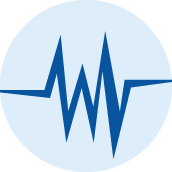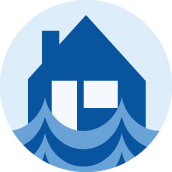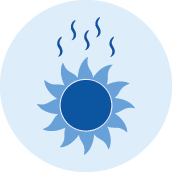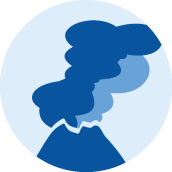TsunamiNgaru taitoko
All of New Zealand’s coastline and large lakes are at risk of tsunami. Knowing the warning signs and the right action to take can help save lives. Find out what to do before, during and after a tsunami.
On this page
Remember: Long or Strong, Get Gone
(The words ‘When an earthquake happens’ are floating on screen. But a sudden shaking breaks them and they fall to the ground.)
When an earthquake happens, you need to think. Is it hard to stand up?
(A figure stands next to the floating words ‘Is it hard to stand up?’. But the ground starts shaking and the words break and fall to the ground. The figure drops to their hands and knees and covers their head with their hands.)
Or has it lasted longer than a minute?
(The figure on the floor stays where they are while the words ‘Or has it lasted…’ appear on screen. The figure raises their head while the words ‘… Longer than a minute’ also appear. The words tick down from the top of the screen like the hand of a clock.)
(A picture of a hill with some houses on it now fills the screen. The ocean is at the bottom of the hill.)
Then, if you’re near the coast…
(A location pin hovers above the lowest house.)
… Move immediately to the nearest high ground…
(The ocean becomes a tsunami wave sweeping across the hill. The location pins flies up to the top of the hill out of range of the water.)
… Or as far inland as possible.
(The ocean disappears and the hill falls away to flat land with some houses on it. The location pin is over the house on the far left. The location pin flies off to the right leaving the houses behind.)
(The location pin disappears leaving a figure standing on the ground.)
Don’t wait for an official tsunami warning.
Go immediately.
(The words ‘Go immediately’ appear and bump into the figure causing them to run off screen.)
(The figure is now on top of a hill with their family.)
Then stay there until you’ve been given the all clear.
(A thumbs up icon appears next to the family.)
If an earthquake is Long or Strong, Get Gone.
(The Civil Defence logo appears on screen. The words ‘Long? Or Strong Get Gone’ appear underneath, followed by the url www.civildefence.govt.nz)
If an earthquake is Long or Strong: Get Gone.
Move immediately to the nearest high ground or as far inland as possible. Don’t wait for an official tsunami warning.
(The words ‘When an earthquake happens’ are floating on screen. But a sudden shaking breaks them and they fall to the ground.)
When an earthquake happens, you need to think. Is it hard to stand up?
(A figure stands next to the floating words ‘Is it hard to stand up?’. But the ground starts shaking and the words break and fall to the ground. The figure drops to their hands and knees and covers their head with their hands.)
Or has it lasted longer than a minute?
(The figure on the floor stays where they are while the words ‘Or has it lasted…’ appear on screen. The figure raises their head while the words ‘… Longer than a minute’ also appear. The words tick down from the top of the screen like the hand of a clock.)
(A picture of a hill with some houses on it now fills the screen. The ocean is at the bottom of the hill.)
Then, if you’re near the coast…
(A location pin hovers above the lowest house.)
… Move immediately to the nearest high ground…
(The ocean becomes a tsunami wave sweeping across the hill. The location pins flies up to the top of the hill out of range of the water.)
… Or as far inland as possible.
(The ocean disappears and the hill falls away to flat land with some houses on it. The location pin is over the house on the far left. The location pin flies off to the right leaving the houses behind.)
(The location pin disappears leaving a figure standing on the ground.)
Don’t wait for an official tsunami warning.
Go immediately.
(The words ‘Go immediately’ appear and bump into the figure causing them to run off screen.)
(The figure is now on top of a hill with their family.)
Then stay there until you’ve been given the all clear.
(A thumbs up icon appears next to the family.)
If an earthquake is Long or Strong, Get Gone.
(The Civil Defence logo appears on screen. The words ‘Long? Or Strong Get Gone’ appear underneath, followed by the url www.civildefence.govt.nz)
If an earthquake is Long or Strong: Get Gone.
Move immediately to the nearest high ground or as far inland as possible. Don’t wait for an official tsunami warning.
Reduce the impacts of tsunami
Find out your tsunami risk. Your Civil Defence Emergency Management Group has tsunami evacuation zone maps and advice. Make sure you know where to go, whether you are at home, at work or out and about.
Review your insurance regularly. Having insurance cover for your home and contents is important to help you get back on your feet if you suffer damage in a disaster.

We can't predict disasters, but we can prepare for them. One of the best places to start is with your home. Find out what you can do to make your home safer.
Get ready before a tsunami
- Work out what supplies you may need and make a plan together.
- Know your tsunami evacuation zones. Make sure you know where to go, whether you are at home, at work or on holiday.
- Understand the different types of warnings: Natural, Official and Unofficial.
- Regularly practise your tsunami hīkoi (evacuation walk).

Make a plan online with your whānau to get through an emergency. Think about the things you need every day and work out what you would do if you didn't have them.

Search your home, work or school address to find out if it is in a tsunami evacuation zone. Make sure you know where to go, whether you are at home, at work, or out and about.

In an emergency, you may be stuck at home for three days or more. Your house is already full of emergency items disguised as everyday things. Figure out what supplies you need and make a plan to get through.
What to do during a tsunami or when a tsunami warning is issued
Know the natural warning signs and take action
For a local source tsunami, which could arrive in minutes, there won’t be time for an official warning. It is important to recognise the natural warning signs and act quickly.
Drop, Cover and Hold if there is earthquake shaking. As soon as the shaking stops, move immediately to the nearest high ground or as far inland as you can out of tsunami evacuation zones. Even if you can't get out of your evacuation zone, go as far or as high as you can. Every metre makes a difference.
If you are near a shore and experience any of the following, take action. Do not wait for official warnings.
- Feel a strong earthquake that makes it hard to stand or a long earthquake that lasts more than a minute
- See a sudden rise or fall in sea level
- Hear loud or unusual noises from the sea
Remember, Long or Strong, Get Gone.
Walk, run or cycle if at all possible to reduce the chances of getting stuck in traffic congestion.
Take your animals with you only if it will not delay you. Do not spend time looking for them and if you are not at home, do not return to get them.
While evacuating, avoid hazards caused by earthquake damage, especially fallen power lines.
Do not return until you get an official all-clear message from Civil Defence.
Long or Strong, Get Gone
Remember, Long or Strong, Get Gone.
Drop, Cover and Hold during the shaking. Protect yourself from the earthquake first.
As soon as the shaking stops, move immediately to the nearest high ground or as far inland as you can out of tsunami evacuation zones.
Download Long or Strong, Get Gone Posters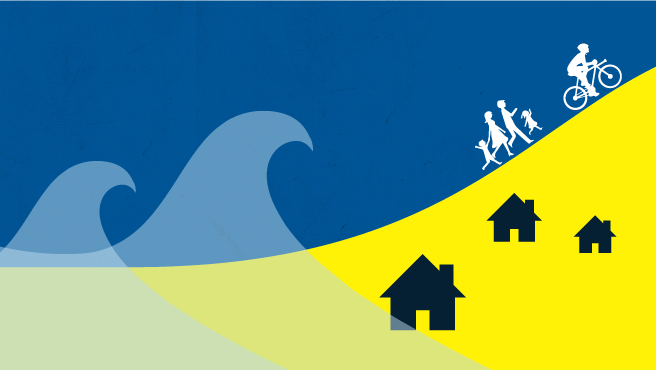
Official warnings
When tsunami travel across the ocean from far away, we have more time to warn people what to do.
Civil Defence issues tsunami warnings in New Zealand.
Tsunami warnings are published on the National Emergency Management Agency's website(external link). Tsunami warnings will also be broadcast on radio and television. An Emergency Mobile Alert may also be issued if there is a threat of flooding of land areas.
Warnings may also be broadcast through:
- siren
- phone
- mobile text
- loud hailer, or
- other local arrangements.
Contact your Civil Defence Emergency Management Group for more advice. They can tell you about the warnings used in your area.
Immediately follow the advice of any emergency warning. Do not wait for more messages before you act.
Unofficial or informal warnings
You might receive informal warnings. Informal warnings could come from:
- friends
- other members of the public
- international media, and
- the internet.
If the warning seems trustworthy, consider evacuating. Check the accuracy of the warning once you have evacuated or en route if it won't slow you down.
If official warnings are available, trust their message over informal warnings.
Lake tsunami
Tsunami can also happen in lakes and other large bodies of water. They can be caused by:
- earthquakes,
- landslides,
- rock falls,
- volcanic eruptions,
- dam failures, and
- glacier collapses.
Even a small earthquake could trigger a landslide at a mountain lake and create a tsunami.
It's important to recognise the natural warning signs and act quickly.
If you are at a lake or any other large body of water and experience the following, move away from the water's edge to higher ground immediately.
- Feel a strong earthquake that makes it hard to stand up. Or a long, weak rolling earthquake that lasts a minute or more. Remember: Long or Strong, Get Gone.
- See a sudden rise or fall in water level. Or unusual waves or water behaviour without an obvious cause.
- See signs of landslides or rock falls.
- Hear loud or unusual noises from the water or surrounding area.

Find your local Civil Defence Emergency Management (CDEM) Group.
What to do after a Tsunami
Only return home once you are told it is safe to do so.
Listen to the radio or follow your Civil Defence Emergency Management Group online. They will give you information and instructions.
If there was an earthquake, expect more shaking. More earthquake shaking may generate another tsunami. Be prepared to evacuate.
Stay away from coastal water, tidal estuaries, rivers and streams for at least 24 hours after any tsunami or tsunami warning. Even small waves create dangerous currents.
Avoid areas impacted by the tsunami. You might hamper rescue and other emergency operations and be at further risk from the residual effects of tsunami flooding.
Help others if you can, especially people who may need extra help.
If your property is damaged
- Do not do anything that puts your safety at risk or causes more damage to your property.
- Contact your insurance company as soon as possible.
- If you rent your property, contact your landlord and your contents insurance company.
- Take photos of any damage. It will help speed up assessments of your claims.

First aid saves lives. Learn what to look for and what to do if you need to give first aid on the St John website.
-
A tsunami is a series of powerful waves with strong current. They can be caused by an earthquake, volcanic eruption, landslide or even a meteorite impact. They can travel many thousands of kilometres across the oceans at speeds of up to 800 kilometres per hour.
Tsunami waves contain considerable energy. They travel much further compared to ordinary coastal waves. Even small tsunami can be dangerous to those in or near the water.
New Zealand’s entire coastline and some of our larger lakes are at risk of tsunami.
Tsunami can flood our shores, causing property damage, injuries and loss of life.
The biggest tsunami in New Zealand are likely to be caused by events close to our shore and can arrive within minutes.
There are three different types of tsunami, depending on where they start.
Distant
Distant tsunami are generated from a long way away, such as from across the Pacific in Chile. In this case, we will have more than three hours warning time for New Zealand. There will be time for official warning messages.
Regional
Regional tsunami are generated between one and three hours travel time. An eruption from an underwater volcano in the Kermadec Trench to the north of New Zealand could create a regional tsunami. There will be time for official warning messages.
Local
Local tsunami come from very close to New Zealand. In this case, there won't be time for an official warning. People in coastal areas need to take immediate action.
Remember: Long or Strong, Get Gone.
If you feel an earthquake that makes it hard to stand or lasts more than a minute, move immediately to higher ground or as far inland as possible out of tsunami evacuation zones.
Resources

Download and print this poster in English. Put it up in your home, school, work or community space. Remember if an earthquake is LONG or STRONG, GET GONE.

Tīkina ake me te tā i tēnei pānui whakaahua. Whakairia ki tō kāinga, ki tō kura, ki tō mahi, ki tō wāhi hapori rānei. Kia maumahara, mehemea ko tētahi rū whenua He Roa, He Kaha rānei, Me Wehe Tonu.
Download and print this poster in Te Reo Māori. Put it up in your home, school, work or community space. Remember if an earthquake is LONG or STRONG, GET GONE.

Download and share this factsheet in English about what to do before, during and after a tsunami.

Tīkina ake, tiria hoki tēnei pukameka mō ngā mahi me whakamahi ā mua, ā roto, ā muri hoki i tētahi ngaru taitoko.
Download and share this factsheet in Te Reo Māori about what to do before, during and after a tsunami.

Learn about our tsunami monitoring and warning system. This guide has been developed for Mayors and people working in local government.
Types of hazards | Ngā momo matepā
In New Zealand we have a lot of natural hazards. Find out what to do before, during and after each type of emergency.
